 MARScom Satellite
MARScom Satellite

US Naval Academy Satellite Lab
Bob Bruninga, WB4APR
Bo Linfors, HQNAVMARCORMARS
MARScom OPS: For current operations notes, see the MARScom OPS page.
MARScom Search: As of early Feb, MARScom is finally drifting ahead of RAFT and so we no longer have the conflict of both satellites being in view at the same time. . Everyone is invited to listen for weak downlink packets on 27.9625 USB once every minute. . Authorized users are welcome to PING the satellite with UNPROTO APRS VIA NMARS packets on the 148.975 FM uplink. . THese digipeated PING packets should make it easier to know when to listen.
MARScom Satellite: The MARSCOM picosat was carried to orbit on STS-116 on 9 Dec 2006 and was activated on deployment from the shuttle at 0156z on 21 December. (see video). MARScom is one of two Naval Academy small cubesats in a two-satellite constellation as part of the RAFT project. See that page for overall mission and programatics and detail design information. This page concentrates solely on the MARScom specific mission.
WEB PAGE SUMMARY: This web page is in reverse chronological order. . New stuff is maintained at the top, and older info is pushed down the page. . But everything is here.
OPERATIONS: Since MARScom is deployed at the same time as 4 other satellite transponders on the same mission at the same time and all under the primary control of the Naval Academy Satellite Grond station, MARScom activation and operation will be delayed until all other initial testing is complete. At the low altitude of this orbit, passes only last for 5 to 8 minutes and there is a lot to do during that time.
PLEASE see the overall ANDE-RAFT-NMARS OPERATIONS page .
MARS STATION OPERATIONS: Since MARScom will be hard to track and tune due to the high Doppler on the 27.965.2 LSB downlink, stations will need to ping the spacecraft to hear a downlink for tuning. For this reason, the initial operations plan for MARScom is simply to have ground stations hone their downlink tuning skills by transmitting occasional packets on the 148.975 FM uplink. WHile also attempting to tune in and capture any telemetry packets as well as their successful packets. Here are the settings for your TNC:
With these settings, you should be able to send a packet via NMARS each time you hit the CARRIAGE-RETURN key. Send any captured packets to the NMARS Telemetry coordinator. [We need such a volunteer?]
ORIGINAL WEB PAGE AND HISTORY BEGINS HERE:
CUBESATS: MARScom was conceived from a number of cubesat ideas following the 4" Stanford Cubesat design concepts and a previous DOD cubesat launch called MEPSI, and MEMS. But this mission expands the size to a 5" cube for nearly twice the mass and volume and a 50% increase in power.
MARScom Mission: The mission of MARScom is to explore and demonstrate a
very low cost yet viable communications capability for education and
training of both Midshipmen and the large numbers of Navy Marine Corps communications
cadre personnel. The downlink will be available to all MARS stations, and the uplink
will be operated as a directed net amongst authorized MARS command stations. We need
volunteer command and operating stations. The requirements are:
NET OPERATIONS: We also would like to have a cadre of MARS operators to brainstorm how we should use this asset during it's estimated 3-5 months life span. We are looking for a volunteer to manage and coordinate such routine operations of MARScom.
HISTORY: We had pondered the idea for a Navy/Marine Corps Military Affilliate Radio System (MARS) Satellite for a long time, but the pieces of the puzzle came together on 13 Dec 2002, during a briefing at NNSOC for the Naval Academy Aerospace faculty. Several pieces seemed to fall into place to suggest that it is time for a Satellite for the MARS cadre:
MARS links: Navy/Marine Corps, Army, Air Force.
MARScom PHOTOS: MARScom was delivered to NASA JSC on 25 Jan 2006 for launch on Space Shuttle STS-116. STS-116 achieved orbit on 9 December 2006. The following photos detail its construction:
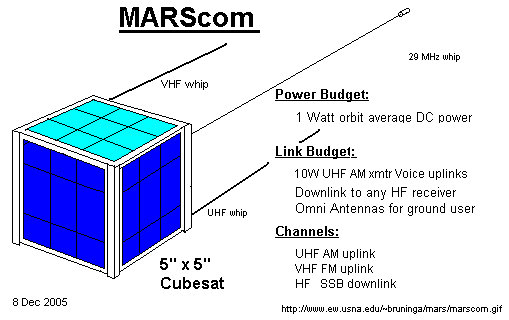
MARS AFLOAT and MIDSHIPMEN SUMMER CRUISES:
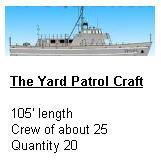 Further, during Midshipmen summer cruise, MARScom will
expose the entire 3rd class of midshipmen to space operations as part of their
professional development. The Academy sends over 400 midshipmen to sea on its fleet
of 20 Yard Patrol Craft in four 3 week long blocks. During this time frame there
is ample opportunity for students to use their on-board PC tools to predict
the MARScom passes and to communicate briefly their status back to the MARS Afloat
Network and possibly exchange simple imagry.
Currently there is no other Navy or DOD asset that can be used innexpensively for this
task. The Naval Academy is part of the Navy Marine Corps MARS program and
holds the callsign of NNN0NNN.
Further, during Midshipmen summer cruise, MARScom will
expose the entire 3rd class of midshipmen to space operations as part of their
professional development. The Academy sends over 400 midshipmen to sea on its fleet
of 20 Yard Patrol Craft in four 3 week long blocks. During this time frame there
is ample opportunity for students to use their on-board PC tools to predict
the MARScom passes and to communicate briefly their status back to the MARS Afloat
Network and possibly exchange simple imagry.
Currently there is no other Navy or DOD asset that can be used innexpensively for this
task. The Naval Academy is part of the Navy Marine Corps MARS program and
holds the callsign of NNN0NNN.
COMMUNICATIONS PAYLOAD: The MARScom transponder can provide both voice, data and imagry communications with a downlink using EXISTING low-cost communications equipment both in the hands of the large MARS cadre of personnel and also available on the Naval Academy's Yard Patrol Craft. That is, Single Sideband Transceivers that can tune the 28 MHz downlink band. At this low frequency, the link budget from space only requires about .03 watt per KHz of bandwidth. Thus a 6 KHz wide transponder with only one Watt EIRP of RF power could provide usable reliable communications with a 6 dB of link margin for less than optimum conditions. Currenlty however, the design will simply downlink the single channel uplink audio in a 3 KHz bandwidth.
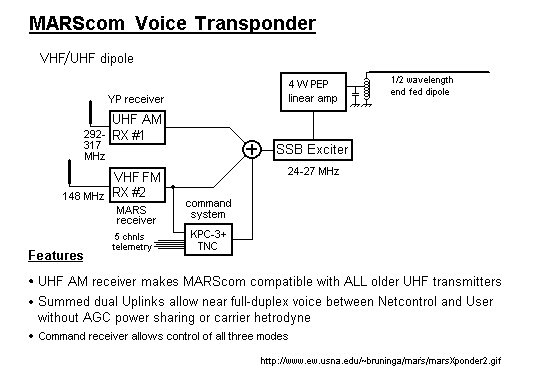
HF DOWNLINK: An unusual feature of MARScom is the HF downlink. This is unusual in the DOD, but is a very popular weak signal mode used by many satellties operating in the Amateur Satelltie Service (OSCAR's 6, 7 & 8, and most Russian RS1 through 15). The reason for its popularity is the low spacecraft transmitter power requirements, and the ready availabliliy of HF receivers and wide bandwidths available in what is otherwise a quite underutilized portion of the spectrum (24-29 MHz).
Although there are no other military HF satellite transponders, this is a paradox because EVERY military outfit, or vehicle has an HF transceiver that is often quite underutilized. Thus the MARScom HF compatible Satellite transponder is receivable by any DOD asset with existing HF equipment.
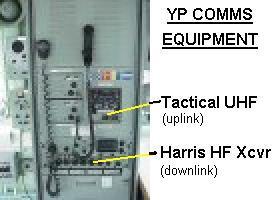 UHF UPLINK:
Another unusual element of this design is the use
of Amplitude Modulated (AM) for the UHF uplink. While this is less than optimum
for satellite links, it takes advantage of equipment already on the Naval Academy YP's
and other low priority military platforms. Historically, every
military asset used UHF AM as the primary tactical communications mode. It
was only natural to use the same UHF spectrum for Satellite communications in the
1970's, but the requirement for operating through satellites also required Transmit
and Receive offsets and FM was superior in signal to noise. Thus all units
needing access to the SATCOM had to upgrade to the new WSC-3 UHF transceivers.
And all low echelon units (jeeps, small boats and YP's) were left with only UHF AM.
UHF UPLINK:
Another unusual element of this design is the use
of Amplitude Modulated (AM) for the UHF uplink. While this is less than optimum
for satellite links, it takes advantage of equipment already on the Naval Academy YP's
and other low priority military platforms. Historically, every
military asset used UHF AM as the primary tactical communications mode. It
was only natural to use the same UHF spectrum for Satellite communications in the
1970's, but the requirement for operating through satellites also required Transmit
and Receive offsets and FM was superior in signal to noise. Thus all units
needing access to the SATCOM had to upgrade to the new WSC-3 UHF transceivers.
And all low echelon units (jeeps, small boats and YP's) were left with only UHF AM.
UHF-AM:Rather than arguing for a multi-million dollar upgrade to SATCOM for the YP's, the path of least resistance is to build a UHF AM compatible satellite instead. The 10 Watt tactical UHF transceivers on the YP's are adequate to close the link to a LEO spacecraft. Secondly, MARS members qualify for surplus governemnt equipment (and there are lots of old UHF AM transceivers abandoned as the military moved to FM and Satellite communications). Thirdly, as shown below, it is easy to build such a transmitter.

FLIGHT CONFIGURATION: Please note, however, that 2 days before delivery of the flight unit, it was found that the UHF down converter front-end transistor had failed and since this was a custom built system, there were no immediate fix. Instead we bypassed the antenna directly to the 118-137 MHz AM IF receiver and chose the USA Search And Rescue frequency 123.1 MHz as a continuation of this mission element. The transponder can be used to monitor SAR events.
PSK-31: We investigated adding a state-of-the-art DSP mode called PSK-31 to the MARScom satellite which is able to support over 20 simultaneous narrowband Teletype channels in a single 3 KHz bandwidth. [Again, this transponder is not currently in the design due to mass constraints]. The popularity of PSK-31 arrises for its extreme simplicity. In the year 1999, Peter Martinez released his PSK-31 software into the public domain which allows any PC with a sound card to both send and receive PSK-31 digital communications with no additonal hardware beyond a simple Microphone and Speaker connection to a radio. Thus, a NO-COST user terminal system. For the MARScom Satellite, another HF SSB frequency could be used for the uplink. Because SSB is a linear mode, dozens of users can simultaneously be transmitting on the same 3 KHz uplink with their PC chosing any of the dozens of audio sub channels in the bandwidth.
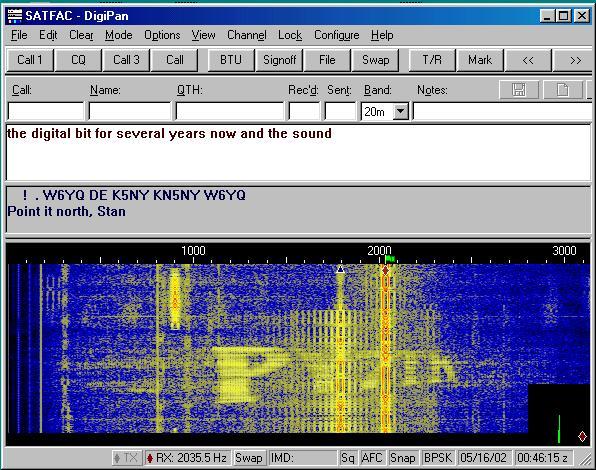
SSTV IMAGRY: The Voice and/or PSK-31 channels can also be used to exchange low resolution imagry via MARScom using the venerable SSTV (Slow Scan TV) technique. The Naval Academy Satellite Ground station has used this on a number of tactical events while using our satellite and other radio communications to track the Army/Navy Game football run every year. See samples. Think of it as exchanging small WEB-CAM images. It takes about 40 seconds per image through the 3 KHz bandwidth.
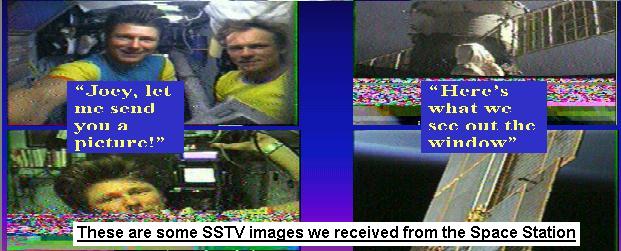
PLAIN LANGUAGE: The use of Plain Language on this transponder was an issue because it challenges policy for communications via space. But the Navy MARS program has always been unclassified and used plain language. There has not been a requirement to do otherwise and there is no need in this case to change that policy. Navy MARS communications have always used HF which is GLOBAL in nature and which propogates worldwide via reflection off the ionosphere using transmitters of hundreds of watts ERP. Using a 1 Watt transmitter on the SAME frequencies in the midst of the SAME ionosphere and the SAME propogation conditions gives no logical cause to require encryption where it does not presently exist. Further this is a training mission with no operational or administrative traffic. Any concerns can be easily solved by policy.
FREQUENCIES: MARS frequencies are unpublished but there are some HF frequencies available in the range above 24 MHz. Although these were never intended for Space communications, the ITU has set precedence by authorizing ALL HF bands in the Amateur Satellite Service to be used for Space communications since common sense suggests that these frequencies can propogate worldwide anyway, so there is nothing unique about their application from space with regard to coordination issues. The same common sense should apply to MARS Frequencies.
SHARED VHF FREQUENCY USE BETWEEN EXISTING VHF REPEATERS AND MARSCOM:
In order to improve our chances of finding a clear VHF uplink channel, we requested the most commonly used MARS VHF frequency in CONUS. It is shared by as many as 79 ground voice repeaters. Using this channel minimizes our chance of interference from other services over CONUS but maximizes our potential for mutual self interference with MARS ground VHF nets. However, for the short (under 6 months) mission of MARScom, the sharing of this channel can be quite workable. Please see the draft MARScom Operations Plan .
TRAINING SYLLABUS: This MARScom satellite project is a bottom up solution to a training opportunity taking advantage of what we CAN DO EASILY to indroduce simple Space communications concepts to the broadest entry level of future naval officers and the existing space cadre. Its mission is only to expose trainees to the LEO space environment and concepts of satellite links, tracking, scheduling, and the limitations of bandwidth and view times. We can do this. Adding other requirements, higher bandwidths, or changing equipment requirements negating the use of existing and off-the-shelf equipment would make the project unworkable. The following is just an outline of some SPACE training objectives that could be met:
The RAFT satellite project at USNA was approved by the Space Experiments Review Board (SERB) and this MARScom mission as the primary communications payload on one of the two small cubesats, seems to be a perfect mission.
DESIGN DETAILS:
You are visitor:
Send comments, suggestions, feedback to bruninga@usna.edu
since 13 Dec 2002. Was 2880 on 15 Apr 2004.
|
|
|
|